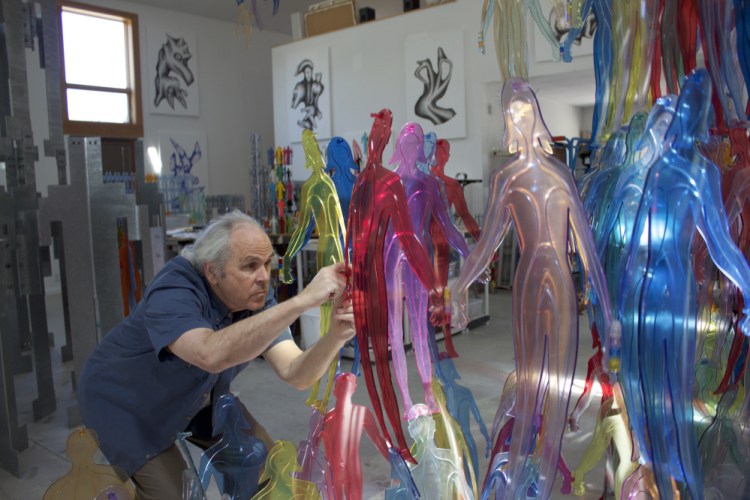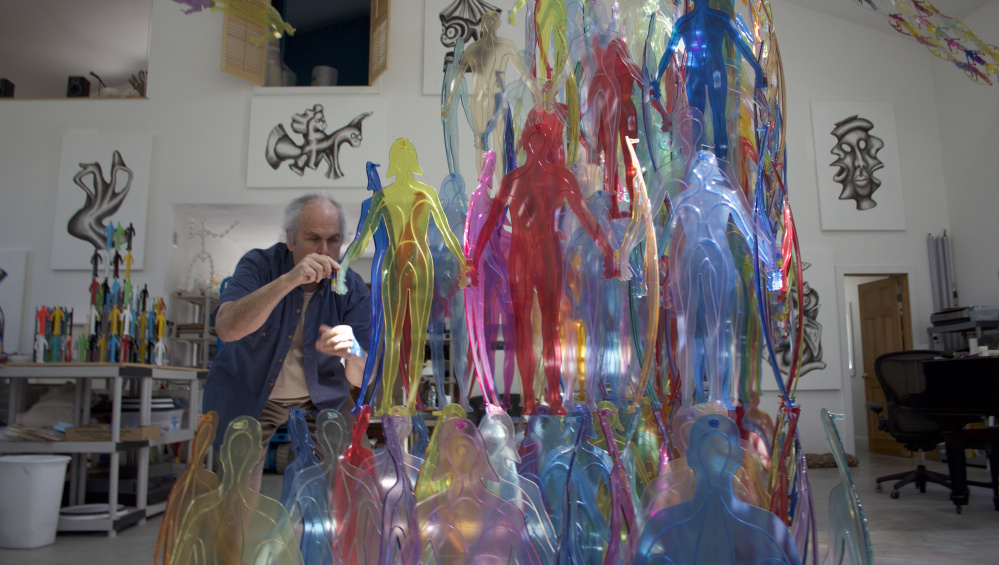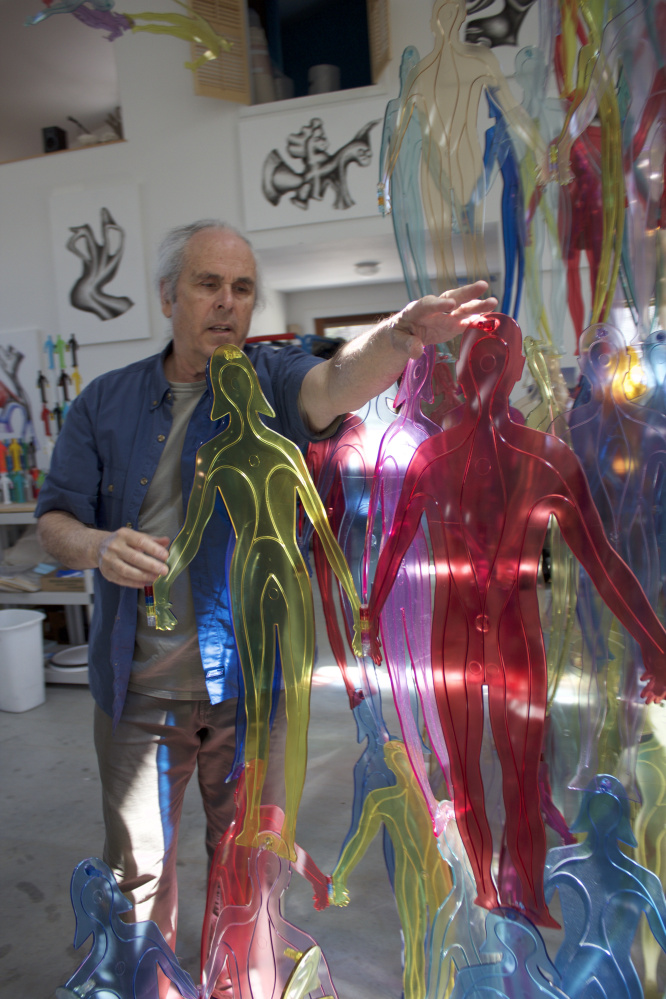WELLS — Jonathan Borofsky isn’t seeking your attention. He doesn’t care if you recognize his name. And he’s not particularly interested in having his photo taken for this newspaper – or any other.
Borofsky, a sculptor from Ogunquit, may be the most famous artist from Maine you’ve never heard of, which is as he likes it. “Maine is my protective zone,” he says. “It’s my safety zone.”
When offered the inaugural exhibition at the new Center for Maine Contemporary Art in Rockland, his initial reply was measured. “I’m not so sure,” he said.
Despite his misgivings, Borofsky ultimately said yes. The new CMCA opens in late June and will feature Borofsky’s sculptures and paintings in an installation titled “Human Structures.” No art show in Maine will get more attention this year, because of the place and the artist. The new museum is a high-profile building, designed by an architect with an international reputation, to accommodate large-scale contemporary art. Borofsky is uniquely qualified to fill the space.
Borofsky’s towering steel sculptures of walking and working men populate cities across Europe and Asia. Despite the efforts of the former director of the Maine Arts Commission to place a Borofsky walking man alongside the Maine Turnpike, he’s never shown his art in Maine, save for a painting or two that hung the summer he was 16 at the Barn Gallery in Ogunquit. “But nothing since then,” said Borofsky, now 73.
Borofsky said yes to CMCA because he fell in love with the space.
A mutual friend introduced museum director Suzette McAvoy to Borofsky. She sent him photos and architectural renderings of the new building. The main gallery is nearly 50 feet square with ceilings that range from 16 to 20 feet high and a steady flow of north-facing natural light. Those dimensions are almost identical to Borofsky’s studio in Wells, and the light is better. “Wow, look at this,” he told his studio assistant when he looked closely at the photos that McAvoy sent. “We’d better go up and take a look. This is serious.”
Borofsky’s primary installations will consist of interlocking human forms, in steel and molded transparent polycarbonate. The plasticlike, transparent bodies look like stained glass, in shades of red, blue and yellow. He covers the steel forms with marine paint in yellow, black, white, green, red and a dull pink.
Borofsky builds the steel pieces as towers, bolting the forms together, hand to hand and head to foot, to create colorful totemic structures that are engineered to withstand winds up to 120 miles an hour. Each individual figure is 6 or 8 feet tall, depending on the design. They look like digital droids from an early-generation computer game, Borofsky’s acknowledgment that our world is connected by pixels and numbers. “We live in a digital world,” he said. “It seemed appropriate my structural design for steel pieces would have a more computer-like design.”
As he joins one form to another, the structure grows in height and girth. He’s built them as tall as 65 feet for the “People Tower” at the Beijing Olympics. At CMCA, his tallest steel structure will be 24 feet, constructed in the outdoor courtyard that fronts Winter Street. An indoor steel piece will be 18-feet tall, fitting snug in the gallery with 20-foot ceilings. Borofsky’s four-member team will begin installing in early June, with help from the CMCA staff.
The transparent forms are 32 inches with similar interlocking patterns – hand to hand and head to foot. Unlike the steel pieces, these are flexible. Borofsky shapes and curves them to adapt to the space, and they are light enough to suspend from the ceilings and hang from walls. He engineered them with a 3D CAD designer from Kennebunk, and cast them in Sanford by the hundreds.
When asked how long he’s used figures in his work, Borofsky quickly answered that he has always used them. A week after his response, he emailed with a clarification: “I believe I truly started specifically using figuration around 1970. The figure became necessary to illustrate my personal dreams that I was recording nearly every morning.”
His other body of work at CMCA involves small drawings that start as bedtime sketches on index cards, which Borofsky later turns into large acrylic paintings. He sketches most nights, as his wife reads in bed beside him. The drawings are fanciful amalgamations of animal and human forms that he conjures in his imagination, combining elements of horse and human and adding wings to creatures that look like they should not fly.
Both bodies of work – the sculpture and the bedtime drawings – speak to the issue of connectivity among living things, which Borofsky has explored since those early personal illustrations. What began as a dream became, eventually, an archetypal towering figure.
“Using the human form as a symbol helps me to understand the connection between my psychological and philosophical self and the world around me,” he said. “I’m trying in both cases to explore who I am and who we all are. It’s part of a learning process.”
These aren’t just human forms holding hands, he said. “It’s about humanity building itself.”
Because of the size of the work, Borofsky installs most of his sculptures outdoors. He is best known for his “Hammering Man,” a tall laborer, standing upright, with a hammer in hand. He’s installed hammering men in Korea, Germany, Switzerland, Norway and England and across America, from Seattle to New York. He set three “Molecule Men” structures, at 100 feet tall, in a river in Berlin, and his “Walking to the Sky” was installed at Carnegie Mellon University in Pittsburgh a decade ago.
People in Boston know his work, too. In 2000, the Museum of Fine Arts installed a version of the “Walking Man,” a colorful little guy in blue pants and a red short-sleeve shirt striding purposefully along an elevated beam above the entrance to a surface-level parking lot.
A ‘WALKING MAN’ WELCOME
If Donna McNeil had her way, there would be a “Walking Man” welcoming people to Maine on the turnpike. McNeil, the former director of the Maine Arts Commission, lobbied hard to convince the Maine Turnpike Authority to install a larger version along the side of the highway “as a symbol of the state of Maine’s support of the arts,” McNeill recalled.
McNeil knew Borofksy from an Ogunquit connection. She ran the Barn Gallery, and Borofsky was a presence in town.
She approached him about the turnpike idea, which he endorsed. McNeil couldn’t convince the Turnpike Authority to pursue it, so she dropped it.
But Borofsky is exactly the kind of artist Maine should celebrate, she said. He’s a longtime Mainer with deep roots, whose art is in public collections around the world. And yet, he’s largely unknown in his home state, mostly because there has been no outlet for his work or no organization willing to pay for it. His pubic pieces can cost from several hundred thousands dollars to a $1 million or more.
Borofsky grew up in Newton, Massachusetts, to parents who encouraged his creativity. His father, Sydney, worked in the textile business, but his passion was music and sports. He played music in restaurants and clubs around Boston, and he played hockey and football for Boston University. He coached the BU hockey team one season, in the 1940s.
Borofsky’s mother was an architect who also painted and ran an art gallery. Borofsky became an artist because of his mother’s influence. His mother’s instructor was the European painter Albert Alcalay, an immigrant and concentration camp survivor from Yugoslavia, who made his way to Boston. Borofsky took lessons from Alcalay. “I liked his paintings,” Borofsky said. “They were abstract, but they looked like cities and I connected them to the real world.”
Alcalay told him he should do what he wanted to do with his life. Borofsky chose art.
“The art stuff was always there,” he said. “My mother used to get art magazines from Europe or the Metropolitan Museum, and they’d be there on our coffee table. I was 9, 10 years old.”
He remembers looking at pictures by Picasso and Gauguin and feeling his world expand. At that young age, he began asking himself, “Where do I come from and where am I going?”
“My work has always been about yearning to be free, all humanity trying to be free or fighting to be free,” he said.
It’s about finding a place in the world, amid the chaos, where we connect as human beings, one to one.
Borofsky’s decision to not show his work in Maine wasn’t conscious. It was largely a matter of circumstance – there was never a suitable scenario until now. Certainly, his desire to retain his privacy factored into it, but despite the worldwide nature of his art, Borofsky has never been widely known.
In Frankfurt, 20,000 cars a day whiz by his “Hammering Man.” The drivers and passengers in those cars do not know his name and probably don’t care.
Which is fine with him.
Send questions/comments to the editors.






Success. Please wait for the page to reload. If the page does not reload within 5 seconds, please refresh the page.
Enter your email and password to access comments.
Hi, to comment on stories you must . This profile is in addition to your subscription and website login.
Already have a commenting profile? .
Invalid username/password.
Please check your email to confirm and complete your registration.
Only subscribers are eligible to post comments. Please subscribe or login first for digital access. Here’s why.
Use the form below to reset your password. When you've submitted your account email, we will send an email with a reset code.